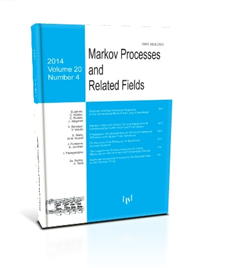A Very Brief Report of the SLE Day at IHP
W. Werner
2007, v.13, Issue 4, 631-636
ABSTRACT
The Stochastic Loewner Evolutions introduced by Oded Schramm in [O. Schramm, Scaling limits of loop-erased random walks and uniform spanning trees. Israel J. Math., 2000, v.118, pp.221-288] are random two-dimensional curves that are defined via iterations of identically distributed random conformal maps. Their properties (fractal dimensions, probabilities of certain events) can be studied, because the framework used to define SLE (the combination of stochastic analysis and of Loewner's equation from classical complex analysis) makes it well-suited to computations. Two-dimensional lattice models can be described by its interfaces (i.e., the interfaces between clusters of sites that have the same spin, for instance). When these systems are precisely at their critical temperature, it is expected and in some times it is proved, that their large-scale behavior is close to that of a continuous scaling limit. Physicists have been very successful in describing this large-scale behavior, mainly via its critical exponents, using elaborate techniques known under the names of Coulomb Gas, Conformal Field Theory or Quantum gravity}. However, even if these theories build on rigorous mathematical concepts (related to representation theory for instance in the case of Conformal Field Theory), the relation between them and the actual two-dimensional system remained somewhat mysterious on the rigorous level. The SLE processes have in a certain sense completely changed this situation. The conjectures become clear: The discrete interfaces should converge (in law) in the scaling limit to the SLE curves. And they should then be more or less directly related to these other theories. There has been a lot of activity on this field during the last few years. There exist now many surveys (for mathematicians and for physicists), lecture notes, a book, that can help to get acquainted to this subject. The purpose of this day organised in January 2006 was to bring together mathematicians and physicists working on these themes to hear about recent advances and ideas in this field. The following is an extremely brief summary of each of the talks, with references to papers related to their content. Jesper Jacobsen did write an extended paper based on his talk that is published in this volume.
COMMENTS
Please log in or register to leave a comment

